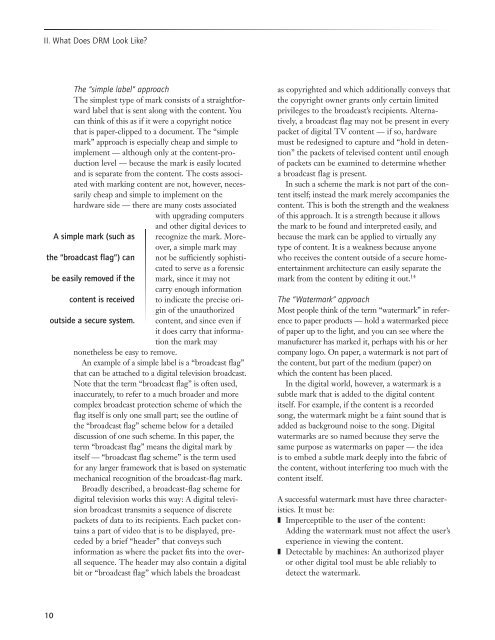What Every Citizen Should Know About DRM, aka - Public Knowledge
What Every Citizen Should Know About DRM, aka - Public Knowledge
What Every Citizen Should Know About DRM, aka - Public Knowledge
Create successful ePaper yourself
Turn your PDF publications into a flip-book with our unique Google optimized e-Paper software.
II. <strong>What</strong> Does <strong>DRM</strong> Look Like?The “simple label” approachThe simplest type of mark consists of a straightforwardlabel that is sent along with the content. Youcan think of this as if it were a copyright noticethat is paper-clipped to a document. The “simplemark” approach is especially cheap and simple toimplement — although only at the content-productionlevel — because the mark is easily locatedand is separate from the content. The costs associatedwith marking content are not, however, necessarilycheap and simple to implement on thehardware side — there are many costs associatedwith upgrading computersand other digital devices toA simple mark (such as recognize the mark. Moreover,a simple mark maythe “broadcast flag”) can not be sufficiently sophisticatedto serve as a forensicbe easily removed if the mark, since it may notcarry enough informationcontent is received to indicate the precise originof the unauthorizedoutside a secure system. content, and since even ifit does carry that informationthe mark maynonetheless be easy to remove.An example of a simple label is a “broadcast flag”that can be attached to a digital television broadcast.Note that the term “broadcast flag” is often used,inaccurately, to refer to a much broader and morecomplex broadcast protection scheme of which theflag itself is only one small part; see the outline ofthe “broadcast flag” scheme below for a detaileddiscussion of one such scheme. In this paper, theterm “broadcast flag” means the digital mark byitself — “broadcast flag scheme” is the term usedfor any larger framework that is based on systematicmechanical recognition of the broadcast-flag mark.Broadly described, a broadcast-flag scheme fordigital television works this way: A digital televisionbroadcast transmits a sequence of discretepackets of data to its recipients. Each packet containsa part of video that is to be displayed, precededby a brief “header” that conveys suchinformation as where the packet fits into the overallsequence. The header may also contain a digitalbit or “broadcast flag” which labels the broadcastas copyrighted and which additionally conveys thatthe copyright owner grants only certain limitedprivileges to the broadcast’s recipients. Alternatively,a broadcast flag may not be present in everypacket of digital TV content — if so, hardwaremust be redesigned to capture and “hold in detention”the packets of televised content until enoughof packets can be examined to determine whethera broadcast flag is present.In such a scheme the mark is not part of the contentitself; instead the mark merely accompanies thecontent. This is both the strength and the weaknessof this approach. It is a strength because it allowsthe mark to be found and interpreted easily, andbecause the mark can be applied to virtually anytype of content. It is a weakness because anyonewho receives the content outside of a secure homeentertainmentarchitecture can easily separate themark from the content by editing it out. 14The “Watermark” approachMost people think of the term “watermark” in referenceto paper products — hold a watermarked pieceof paper up to the light, and you can see where themanufacturer has marked it, perhaps with his or hercompany logo. On paper, a watermark is not part ofthe content, but part of the medium (paper) onwhich the content has been placed.In the digital world, however, a watermark is asubtle mark that is added to the digital contentitself. For example, if the content is a recordedsong, the watermark might be a faint sound that isadded as background noise to the song. Digitalwatermarks are so named because they serve thesame purpose as watermarks on paper — the ideais to embed a subtle mark deeply into the fabric ofthe content, without interfering too much with thecontent itself.A successful watermark must have three characteristics.It must be:❚ Imperceptible to the user of the content:Adding the watermark must not affect the user’sexperience in viewing the content.❚ Detectable by machines: An authorized playeror other digital tool must be able reliably todetect the watermark.10





